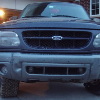mkennedy100
Member
- Joined
- October 4, 2002
- Messages
- 11
- Reaction score
- 5
- City, State
- Maryland
- Year, Model & Trim Level
- 2013 Explorer Limited
Hi All. Recently changed out the water pump on my 2013 Limited and replaced all timing components while I was at it. Watched the YouTube videos by fordtechmakuloco and the tips posted here by mcpcartier (Thanks to both!). Happy to say that it was a success and I think I caught the failing WP before any coolant contaminated the oil (at least based on visual examination). I wanted to pass along a few tidbits that might be helpful to others contemplating this job.

- It’s a big job but more tedious than physical. I followed the FSM but for one key difference: Like mcpcartier suggested, I did not evacuate and disconnect the indicated AC line. The AC line is in an inconvenient location but you can work around it. I used a zip tie to hold it out of the way as much as possible without damaging the line.
- It took me roughly 20 hours split over 3 days in total but I’m slow. I could do it faster now that I’ve done it once but it would still be a 2 day job.
- I was alerted to the problem by a smell of coolant when the engine was hot and the undeniable coolant dribbles on my driveway. Coolant level was also low in the degas tank. Lastly an inspection of the area near the water pump weep hole showed an obvious stream of coolant leaking right after driving when the system was under pressure.
- Get the special tools: the cam shaft holders to keep the cams from rotating and especially the Torx Plus bit. These are different than regular torx. You’ll need the TP-55 size for the cam phaser bolts. All were cheap and available online. I can share links to the products i chose if anyone is interested. I did not find need to use the locating pins as noted in the FSM.
- Honestly for me the worst parts of the job were: 1) reaching and disconnecting all the harness clips from the firewall side valve cover without destroying the clips; 2) maneuvering the front cover back into position without bumping something and messing up the bead of sealant; and 3) the absolutely obscene torque sequence and quantity of bolts involved in snugging down the front cover. If you’ve seen the procedure you know what I mean.
- Practice maneuvering the front cover back into position as many times as you need to get comfortable with your process before applying the sealant and going at it for real
- The crank bolt did not want to budge initially but after a couple mins of heat from a propane torch it came off easily
- The smallest 3 jaw puller in the set from HF worked just fine to remove the crank pulley
- Use a paint pen and mark the bolts as you torque them to final spec. You really don’t want to lose track and have to check them all again especially if you spread the job over a couple of days.
- As indicated in the FSM, I did have to raise and lower the engine slightly to install/remove some of the front cover bolts that were obscured by the frame rail.
- Finally, when tightening the crank bolt or phaser bolts, the camshafts will want to spin. This kept causing the cam holder tool to lift out of position and in one case it popped clean off the camshaft. Doh! To address this, I found that a deep socket (craftsman 9/16” in my case) fit perfectly in the vct solenoid bore and could be used with a wooden shim to wedge the camshaft holder in place. I’ll try to post or attach a pic below.










